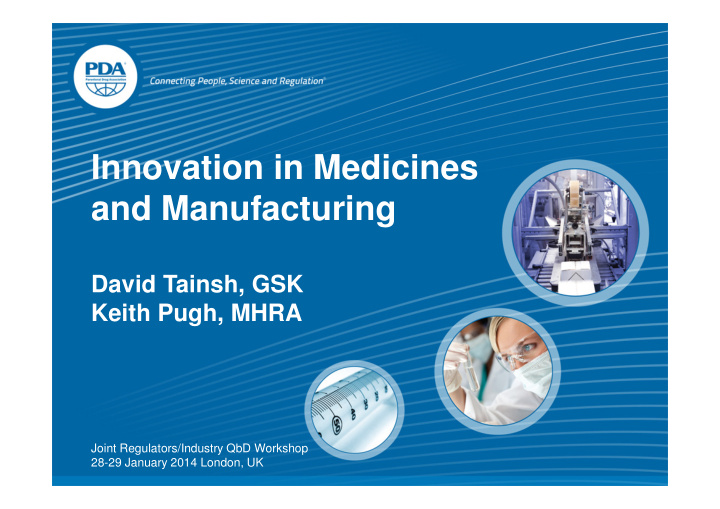



Innovation in Medicines PDA: A Global and Manufacturing Association David Tainsh, GSK Keith Pugh, MHRA Joint Regulators/Industry QbD Workshop 28-29 January 2014 London, UK
Introduction • Current State – We have heard a lot about the challenges and successes of applying QbD – Aside from Biopharms which we know are complex, Immediate Release Products are just the tip of the iceberg and we need to be more innovative if we are to be successful in delivering consistent and reliable quality for all products. • Future State – So before we close this workshop we just wanted to reflect on some of the new challenges facing us, what could be different and to ask how do you see it? 2
Challenges to Innovation • Current Levels of Technical Capability • Availability of New Skillsets • Unwillingness to Deploy New Technology • Large Investment in the Current State • Perceptions of High Regulatory Hurdles • Lack of Process to Manage Complex LCM Changes • Lack of an Overall Vision on How to Modernise Pharmaceutical Manufacture 3
Opportunities for Innovation • Novel Product Types for QbD – More Complex Traditional Medicines • Prolonged release Oral, Inhaled DPI, Nanoparticulates – Novel products • Advanced Therapeutics, Oligonucleotides, Microneedles • Novel Methods of Manufacture & Control – Continuous – Synthetic Biochemistry - Biotransformations – Discrete Manufacture & Novel Analytics • Others? 4
Continuous Manufacturing: - Enabling Things Batch Can’t Do *���!������� �������������������������������� • + ,&����$�!������������ ������������������������������ • + ����������� Process �������������������������� • + *&������ ������������ ���������������� • ��!�� • Factory ����������� ���������� • "����#�������������$ • %��&������'�#����$ Business • �&������#���(�)������ •
Synthetic Biochemistry Moving to Microbial *�������!��������� ����#�����$ Cell Factories �����!�������������!���������$� �������������!&������������&�0� • )������������������������ + -������������!������������� + ������������������(�#$+����&��� + ./&��&��#�����#����������� Cascade Synthesis Chemoenzymatic Approach Enzyme Enzyme
Liquid Dispensing Technology Platform Industrial scale machine installed to provide Phase 3 and Launch Capability Capacity: 1 million tablets/day, upgradable to 2 million/day 7
Manufacturing - A Paradigm Shift Mfg….. Discrete Units Mfg….. Batch “Population of One” “Population of Many” Quality assessed on-line Quality assessed by for every tablet sampling post manufacture 8
Liquid Dispensing Technology with PAT UV / NIR 1. Vision system, 1. Image analysis [suspension droplet size 2. NIR Chemical concentration] 2. Droplet weight Imaging IR or Microwave On-Line Surface Drug Solution or Low Volume Drying Analysis Coating Suspension (c. 2-20ul) Chemical & Printing + Placebo Tablets Dispensing Imaging No Linkage between First and Last Tablet 9
Process Analytical Technologies Video Image of Droplet: NIR Chemical Imaging: “What was Delivered” “Where on the Tablet” 10
Comparison of Droplet Content Uniformity vs Typical 2mg Tablet Content Uniformity Droplet LSL -3.s +3.s USL 350 N= 606 300 PpK =16 250 Frequency 200 150 85% 115% 100 50 0 6.94E6 6.96E6 6.98E6 7E6 7.02E6 7.04E6 7.06E6 7.08E6 7.1E6 7.12E6 7.14E6 7.16E6 7.18E6 7.2E6 7.22E6 7.24E6 7.26E6 7.28E6 7.3E6 7.32E6 7.34E6 7.36E6 LSL -3.*S N ominal +3.*S U SL 150 Tablet 125 N= 520 100 PpK =1.4 75 50 25 0 11 80 82 84 86 88 90 92 94 96 98 100102104 10 6 108110112114116 11 8
Control and Testing Drop Volume/Dose NIR Dose Content Position UV Inspection Solution Analysis Tunnel Temp. 100% Vision Conditions QC Inspection 100% Vision QC Inspection Reticule Calibration Coating & Incoming Dosing Drying Printing core tablet Wet Dose Position Droplet Pad Inspection/ Inspection Weight Check Coating Confirmation System monitoring – tablet shift register and rejection confirmation 12
Desired State • A Vision to Modernise Pharmaceutical Manufacture • Enabling Regulatory Strategy and Process that keeps pace with Innovation • Increased Opportunities for Scientific Dialogue around innovative platforms • Education and Training to Provide New Skillsets • Enhanced scientific and risk based approaches to QbD to match new technologies • A Simplified and Streamlined Variations Process 13
Challenges to Innovation • Current Levels of Technical Capability • Availability of New Skillsets • Unwillingness to Deploy New Technology • Large Investment in the Current State • Perceptions of High Regulatory Hurdles • Lack of Process to Manage Complex LCM Changes • Lack of an Overall Vision on How to Modernise Pharmaceutical Manufacture 14
Desired State • A Vision to Modernise Pharmaceutical Manufacture - Industry driven • Enabling Regulatory Strategy and Process that keeps pace with Innovation – Facilitate within existing Regulation 15
Desired State • Increased Opportunities for Scientific Dialogue around innovative platforms - Scientific Advice (EMA/NCA) - Working Parties e.g. QWP, BWP - PAT team - early interactions recommended • Education and Training to Provide New Skillsets - Should also include Regulators 16
Desired State • Enhanced scientific and risk based approaches to QbD to match new technologies - Apply and build on existing learning • A Simplified and Streamlined Variations Process - EU legislation (Common system since August 2013) - Changes already classified on a risk based basis - Detailed classification guideline 17
Summary - Types of Variations Changes not requiring Changes requiring any prior approval prior approval Design Type IA Type IB Type II Extension Space (Default) ‘ Do & tell ’ No submission ‘ Tell, wait & do ’ required if within an Variations approved design space Evaluation Procedure adapted to the level of risk
Desired State • A Simplified and Streamlined Variations Process - EU - Changes already classified on a risk based basis - Additional flexibility – Post Approval Change Management Protocol (PACMP) - justify downgrading in type of required variation - no restrictions to the nature of changes - limit (Type IB) regarding level of downgrading for biopharmaceutical products. - Global challenges - What do you want? 19
Conclusion • By No Means a Comprehensive View of the Challenges Facing All of Us or the Possible Solutions • But a Stimulus for Further Discussion • So How do you See the future Challenges and Opportunities for Innovation? 20
Recommend
More recommend